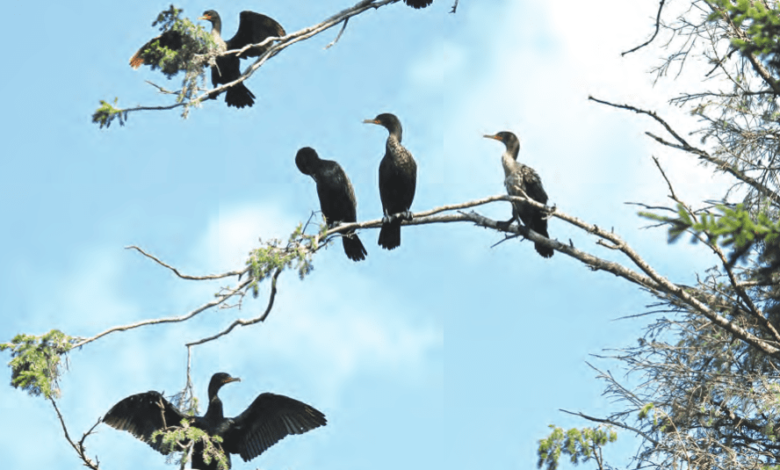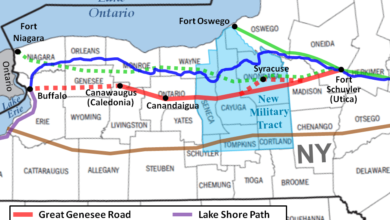Cormorants on Lake Champlain and Lake George


 Lake Champlain’s Four Brothers Islands, an eighteen-acre archipelago owned by the Nature Conservancy and located two miles east of Willsboro Point, are home to the only nesting colony of Double-crested Cormorants in New York State.
Lake Champlain’s Four Brothers Islands, an eighteen-acre archipelago owned by the Nature Conservancy and located two miles east of Willsboro Point, are home to the only nesting colony of Double-crested Cormorants in New York State.
The islands are the likely source of the populations that have been visiting Lake George after a hiatus of several years, roosting in the Mother Bunch, the Waltonians and Diamond Island, among other places.
According to Dave Wick, the executive director of the Lake George Park Commission, approximately 50 cormorants are now seasonal residents of Lake George.
As of now, these transients pose no long-term threat to the majority of Lake George islands, to the lake’s wildlife or to its water quality, a wildlife biologist for the Department of Environmental Conservation, John O’Connor, recently told the Lake George Park Commission.
The visitors are “non-breeding birds. They’re striking out and exploring new areas,” said O’Connor. “If cormorants are roosting in your trees or fishing in your lake, you may not like it, but that’s what they do.”
Among the things limiting the expansion of the population on Lake George islands: predators, human disturbance, the size of the islands. However, “if you see
cormorants nesting, call me right away,” said O’Connor.
Throughout New York, the birds not only denude islands of vegetation; they add nutrients to freshwater bodies that can lead to increased algal growth and which
can contain harmful bacteria such as E. coli, making swimmers sick and contaminating water drawn from lakes.
According to the DEC’s O’Connor, the Double-crested Cormorant was first detected on the Four Brothers Islands in 1951 by Vermont’s Fish and Wildlife Bureau.
The bird was rarely spotted on the islands from the 1950s through the mid-1970s due to the use of DDT; after the pesticide was banned by the U.S. EPA in
1972, the population rebounded throughout the nation. As late as 1984, conservationists still considered the islands “a vast breeding ground for colonial nesting birds.”
The cormorant, however, has a propensity to encroach upon the habitats of other species and to expel competing colonies of birds, some threatened or endangered. That’s among the reasons why the Ne York State Department of Environmental Conservation (DEC) remains interested in controlling the growth of its population there.
From one nesting pair in 1981, when Audubon volunteers counted 45 birds on the islands, the cormorant population grew to 4,000 nests, and in 2008, the DEC began managing the population with permits from the U.S. the US Department of Agriculture’s Wildlife Services Department.
The DEC’s tools include applying corn oil to eggs to prevent them from hatching, destroying nests and in some cases, coordinated shoots. Federal policies changed
in 2016 after “a federal court decision restricted management options,” O’Connor said. “The DEC’s Division of Fish and Wildlife can no longer manage cormorants unless they have a direct impact on wildlife species or their habitats.”
“Because of the other species that nest on Four Brothers Islands, we’ve been given the authority to manage them there,” said O’Connor. Even with policies in place
to manage the cormorant population, the Four Brotherts Islands’ mature pine forests have been reduced to dead snags, O’Connor said.
To get a more detailed and precise profile of Lake George’s cormorants and their impacts on the islands and wildlife, the Lake George Park Commission and the
Department of Environmental Conservation will start surveying the population in 2025, the Park Commission and the DEC have announced.
At a recent Park Commission meeting, the DEC’s O’Connor commented, “We’ll start counting the birds, identifying the locations where they’re roosting and documenting any damage we observe. That will provide us with a base of knowledge going forward.”
“The DEC knows this bird species, and the Lake George Park Commission has a dedicated Marine Patrol that is out on the lake every day,” said Dave Wick, the Park Commission’s executive director.
“Population counts will occur every few weeks, enabling us to get a sense of the timing of the birds’ migration and the size of the population. We will also document any damage to trees on the islands throughout the lake, compiling an annual catalog that shows any identified trends,” said Wick.
Wick added, “this information will be crucial if the federal permit to manage this species on Lake George is amended to help ensure that the iconic islands of the lake are not decimated by cormorant populations.”
A version of this essay first appeared in the Lake George Mirror, America’s oldest resort paper, covering Lake George and its surrounding environs. You can subscribe to the Mirror HERE.
Photo: Double-crested Cormorants.
Source link





